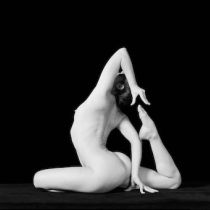I perform a piece with Butoh artist Maureen Fleming in which I play Philip Glass’s Etude No. 5. The performance includes a video of Maureen moving, projected larger-than-life-size on a scrim. Behind the scrim, Maureen performs live. In front of the scrim, onstage, I sit at a piano and play the etude.

Maureen made the video first. She started improvising movements and shooting video, with careful, subtle lighting. The movements are slow and slow changing. Her body makes the shape of a triangle: her back arched, her thighs down flat, one forward, one back, her knees and feet bent up and grasped and ungrasped by her hand behind her back.
The film was made in segments and edited. The angle of the camera shifts very slightly through the finished piece. After the film was nearly complete, Maureen found the music. She fitted Glass’s own recording of his Fifth Piano Etude to the images.
Before our first rehearsals together, Maureen gave me the video with Glass’s playing as the soundtrack. This is music I have played quite often. I didn’t want to copy the details of Philip’s playing. I tried to find the points of coincidence between notable details of the movement, and punctuations and cadences in the music.
My goal was to be able to accompany the film (with the sound turned down), making the phrases of music line up or make sense with Maureen’s filmed movement — without exactly mimicking Philip’s tempos or rhythmic inflections. It’s tricky. Some phrases of the movement patterns go by more quickly. A completely steady, unvaried pace in playing the music is not possible.
Once we got into rehearsals, I played through the music with the video several times, as Maureen drew my attention to details of the movement. “You see my thumb touches the floor there.” Or, ” My chin disappears behind my arm, on ‘four’.”
On stage, Maureen performs these same movements live. She can see some of the projected moving image, and she can hear my playing. Often, her live performance virtually matches the film, but never exactly. I feel that a lot of the beauty and overall emotional quality of the work come from this friction — this failure of the live performing to exactly coincide with the movements seen in the film.
So there are layers:
• There’s the video that doesn’t change (although it’s murkier or easier to see depending on conditions in each theater).
• There’s me trying to match my live playing of the music to what I can see in the video.
• And there’s Maureen watching and listening, and doing the movements in sequence in real time.
I’ve done performances with other dancers using “live video” — real time projection of events taking place in the moment. Some critics and audience members thought my performances with Maureen used live video. Perhaps these observers were mesmerized, and didn’t notice the subtle changing of camera vantage point, or slightly asynchronous cadences.
Live video would be easier. I could play more freely. But then, the fragile, elusive links from the “script” — the pre-made video — to me, and to Maureen, would not be part of the art.

I recently came across your blog and have been reading along. I thought I would leave my first comment. I don’t know what to say except that I have enjoyed reading. Nice blog. I will keep visiting this blog very often.
Barbara
http://keyboardpiano.net